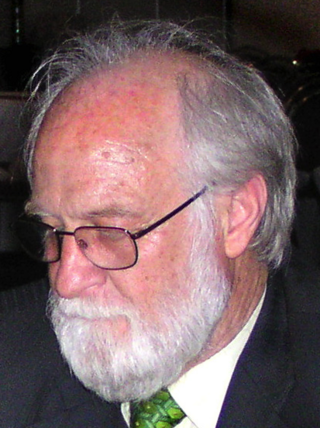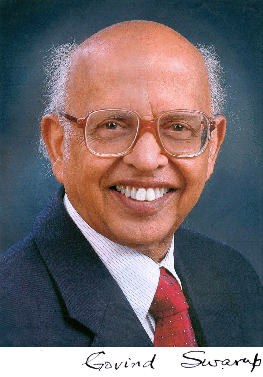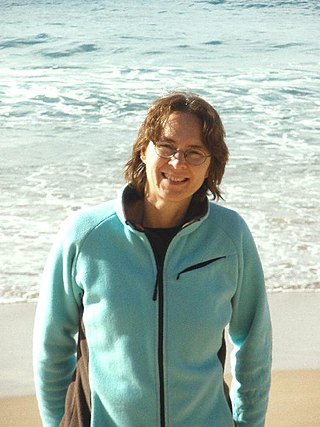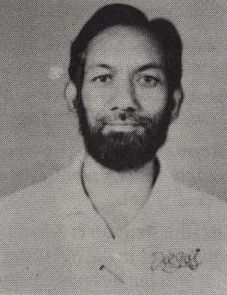Related Research Articles

A radio telescope is a specialized antenna and radio receiver used to detect radio waves from astronomical radio sources in the sky. Radio telescopes are the main observing instrument used in radio astronomy, which studies the radio frequency portion of the electromagnetic spectrum emitted by astronomical objects, just as optical telescopes are the main observing instrument used in traditional optical astronomy which studies the light wave portion of the spectrum coming from astronomical objects. Unlike optical telescopes, radio telescopes can be used in the daytime as well as at night.

The Karl G. Jansky Very Large Array (VLA) is a centimeter-wavelength radio astronomy observatory in the southwestern United States. It lies in central New Mexico on the Plains of San Agustin, between the towns of Magdalena and Datil, approximately 50 miles (80 km) west of Socorro. The VLA comprises twenty-eight 25-meter radio telescopes deployed in a Y-shaped array and all the equipment, instrumentation, and computing power to function as an interferometer. Each of the massive telescopes is mounted on double parallel railroad tracks, so the radius and density of the array can be transformed to adjust the balance between its angular resolution and its surface brightness sensitivity. Astronomers using the VLA have made key observations of black holes and protoplanetary disks around young stars, discovered magnetic filaments and traced complex gas motions at the Milky Way's center, probed the Universe's cosmological parameters, and provided new knowledge about the physical mechanisms that produce radio emission.

Parkes Observatory is a radio astronomy observatory, located 20 kilometres (12 mi) north of the town of Parkes, New South Wales, Australia. It hosts Murriyang, the 64 m CSIRO Parkes Radio Telescope also known as "The Dish", along with two smaller radio telescopes. The 64 m dish was one of several radio antennae used to receive live television images of the Apollo 11 Moon landing. Its scientific contributions over the decades led the ABC to describe it as "the most successful scientific instrument ever built in Australia" after 50 years of operation.

The Square Kilometre Array (SKA) is an intergovernmental international radio telescope project being built in Australia (low-frequency) and South Africa (mid-frequency). The combining infrastructure, the Square Kilometre Array Observatory (SKAO), and headquarters, are located at the Jodrell Bank Observatory in the United Kingdom. The SKA cores are being built in the southern hemisphere, where the view of the Milky Way galaxy is the best and radio interference is at its least.

The Molonglo Observatory Synthesis Telescope (MOST) is a radio telescope operating at 843 MHz. It is operated by the School of Physics of the University of Sydney. The telescope is located in Hoskinstown, near the Molonglo River and Canberra, and was constructed by modification of the east–west arm of the former Molonglo Cross Telescope, a larger version of the Mills Cross Telescope. Construction of the original "Super Cross" telescope with 1.6-kilometre arms began in 1960 by Professor Bernard Y. Mills. It became operational in 1967.

Bryan Malcolm Gaensler is an Australian astronomer based at the University of California, Santa Cruz. He studies magnetars, supernova remnants, and magnetic fields. In 2014, he was appointed as Director of the Dunlap Institute for Astronomy & Astrophysics at the University of Toronto, after James R. Graham's departure. He was the co-chair of the Canadian 2020 Long Range Plan Committee with Pauline Barmby. In 2023, he was appointed as Dean of Physical and Biological Sciences at UC Santa Cruz.

The Murchison Widefield Array (MWA) is a joint project between an international consortium of organisations to construct and operate a low-frequency radio array. 'Widefield' refers to its very large field of view. Operating in the frequency range 70–300 MHz, the main scientific goals of the MWA are to detect neutral atomic Hydrogen emission from the cosmological Epoch of Reionization (EoR), to study the Sun, the heliosphere, the Earth's ionosphere, and radio transient phenomena, as well as map the extragalactic radio sky. It is located at the Murchison Radio-astronomy Observatory (MRO).

The Jodrell Bank Centre for Astrophysics at the University of Manchester, is among the largest astrophysics groups in the UK. It includes the Jodrell Bank Observatory, the MERLIN/VLBI National Facility, and the Jodrell Bank Visitor Centre. The centre was formed after the merger of the Victoria University of Manchester and UMIST which brought two astronomy groups together. The Jodrell Bank site also hosts the headquarters of the SKA Observatory (SKAO) - the International Governmental Organisation (IGO) tasked with the delivery and operation of the Square Kilometre Array, created on the signing of the Rome Convention in 2019. The SKA will be the largest telescope in the world - construction is expected to start at the end of this decade.

Ronald David Ekers FRS FAA is an Australian radio astronomer. His fields of specialty include the study of active galactic nuclei, cosmology, and radio astronomy techniques.

Govind Swarup was a pioneer in radio astronomy. In addition to research contributions in multiple areas of astronomy and astrophysics, he was a driving force behind the building of "ingenious, innovative and powerful observational facilities for front-line research in radio astronomy".

MeerKAT, originally the Karoo Array Telescope, is a radio telescope consisting of 64 antennas in the Meerkat National Park, in the Northern Cape of South Africa. In 2003, South Africa submitted an expression of interest to host the Square Kilometre Array (SKA) Radio Telescope in Africa, and the locally designed and built MeerKAT was incorporated into the first phase of the SKA. MeerKAT was launched in 2018.

John O'Sullivan is an Australian engineer.

The ASKAP radio telescope is a radio telescope array located at Inyarrimanha Ilgari Bundara, the CSIRO Murchison Radio-astronomy Observatory in the Mid West region of Western Australia.

Inyarrimanha Ilgari Bundara, the CSIRO Murchison Radio-astronomy Observatory was established by CSIRO, Australia's national science centre in 2009. It lies in a designated radio quiet zone located near Boolardy Station in the Murchison Shire of Western Australia, about 800 kilometres (500 mi) north of Perth on the traditional lands of the Wajarri people.

Lisa Harvey-Smith is a British-Australian astrophysicist, Australia's Women in STEM Ambassador and a Professor of Practice in Science Communication at the University of NSW. Her research interests include the origin and evolution of cosmic magnetism, supernova remnants, the interstellar medium, massive star formation and astrophysical masers. For almost a decade Harvey-Smith was a research scientist at Australia’s Commonwealth Scientific and Industrial Research Organisation (CSIRO), including several years as the Project Scientist for the Square Kilometre Array Pathfinder and later Project Scientist for the Australian Square Kilometre Array Pathfinder (ASKAP) Telescope.

Dr. Bärbel Silvia Koribalski is a research scientist working on galaxy formation at CSIRO's Australia Telescope National Facility (ATNF), part of CSIRO's Astronomy & Space Science (CASS). She obtained her PhD at the University of Bonn in Germany and is noted for studies of nearby galaxies. In 2011 she received CSIRO's Newton Turner Award. She is also a project leader of the ASKAP HI All-Sky Survey, known as WALLABY.

Warrick John Couch is an Australian professional astronomer. He is currently a professor at Swinburne University of Technology in Melbourne. He was previously the Director of Australia's largest optical observatory, the Australian Astronomical Observatory (AAO). He was also the president of the Australian Institute of Physics (2015–2017), and a non-executive director on the Board of the Giant Magellan Telescope Organization. He was a founding non-executive director of Astronomy Australia Limited.
George Kildare Miley is an Irish-Dutch astronomer. He holds a professorship at Leiden University, where he served as director of Leiden Observatory from 1996 to 2003.

Vijay Kumar Kapahi was an Indian astrophysicist and the director of the National Centre for Radio Astrophysics, an autonomous division of Tata Institute of Fundamental Research. Known for his research on radio galaxies, quasars and observational cosmology, Kapahi was an elected fellow of all the three major Indian science academies – Indian Academy of Sciences, Indian National Science Academy and National Academy of Sciences, India – as well as of the Maharashtra Academy of Sciences. The Council of Scientific and Industrial Research, the apex agency of the Government of India for scientific research, awarded him the Shanti Swarup Bhatnagar Prize for Science and Technology for his contributions to physical sciences in 1987.

Melanie Johnston-Hollitt is an Australian astrophysicist and professor. She has worked on the design, construction, and international governance of several radio telescopes including the Low Frequency Array (LOFAR), the Murchison Widefield Array (MWA) and the upcoming Square Kilometre Array (SKA). She was the director of the Murchison Widefield Array until December 2020 and is a professor at the Curtin Institute of Radio Astronomy at Curtin University and the International Centre for Radio Astronomy Research. Since August 2020, Melanie Johnston-Hollitt is the director of the Curtin Institute for Data Science.
References
- 1 2 "About Us". The Anglo-Australian Telescope. Retrieved 11 January 2015.
- 1 2 "Dr Brian Boyle - CSIRO SKA Director". www.atnf.csiro.au. 20 April 2021. Retrieved 2 June 2021.
- ↑ "Beyond 2000: The Way Ahead", ARC, retrieved 27 April 2011 from "Archived copy" (PDF). Archived from the original (PDF) on 22 April 2011. Retrieved 27 April 2011.
{{cite web}}: CS1 maint: archived copy as title (link) - ↑ National Committee for Astronomy of the Australian Academy of Science (November 2005). New Horizons: A Decadal Plan for Australian Astronomy 2006 – 2015 (PDF). Editorial Note: Commonwealth of Australia. p. 2. ISBN 0-85847-226-0 . Retrieved 28 January 2015.
The Decadal Plan was edited for the National Committee of Astronomy by an Editorial Board comprising Brian Boyle (chair)...
- ↑ "Optical and Radio Astronomy". Archived from the original on 22 April 2011. Retrieved 27 April 2011.
- ↑ "Funding Agreement for the National Collaborative Research Infrastructure Strategy", Astronomy Australia, retrieved 27 April 2011 from "Archived copy" (PDF). Archived from the original on 17 February 2011. Retrieved 27 April 2011.
{{cite web}}: CS1 maint: archived copy as title (link) - ↑ "18 new Fellows elected". Australian Academy of Science. Retrieved 28 January 2015.
- ↑ "Dr Brian Boyle: CSIRO SKA Director". CSIRO Australia Telescope National Facility. 20 July 2022.
- ↑ Boyle, B. J. (1 January 1986). "Clustering and evolution of optically selected quasi-stellar objects". PhD Thesis. Bibcode:1986PhDT.......148B – via NASA ADS.
- ↑ "'Accidental revolutionaries' net US$500,000 cosmology prize", CSIRO, retrieved 15 April 2011 from ""Accidental revolutionaries" net US$500,000 cosmology prize (Media Release)". Archived from the original on 30 April 2010. Retrieved 27 April 2011.
- ↑ "Extract for BOYLE, Brian John Award:Centenary Medal". It's an Honour: Australia Celebrating Australians. Government of the Commonwealth of Australia.
- ↑ "Extract for BOYLE, Brian John Award:Public Service Medal". It's an Honour: Australia Celebrating Australians. Government of the Commonwealth of Australia.